Sep/Oct, 1996 on Page 14. This issue is still available! Click here.
By Dave McCracken
“Having the Gold Mining Adventure of a Lifetime!”
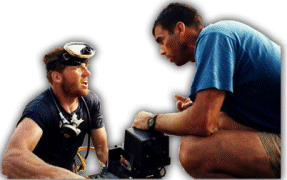
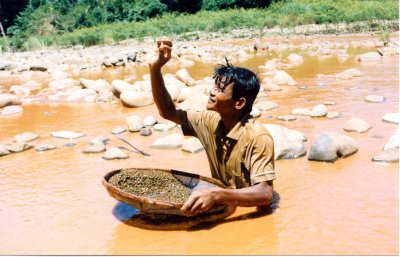 Author’s note: This story is dedicated to Alan Norton (Alley), the lead underwater mining specialist who participated in this project. Under very difficult conditions, Alan made most of the key dives which enabled us to make this a very successful venture. Alan lost part of his ear to a hungry fish one day; and the following day, Alan was making a key sampling dive again because we needed him to. There are very few people I know, if any, with more courage, dedication and enthusiasm to successfully complete a difficult mission than Alan.First came several Toyota Land Cruisers. Then, a couple of Isuzu Troopers, followed by a number of small pickup trucks. These were just in front of two large Russian troop carriers, all filled with armed troops. They came in on us fast, carrying along a big cloud of dust from the dirt road. Even before the vehicles came to a stop, soldiers were jumping out of trucks and running out to secure perimeter positions. They were carrying AK-47 machine guns, M-79 grenade launchers and Chinese rockets. I had seen these guys before. I had fought with them, and I had fought against them. They had that unmistakable look in their eyes. They would kill with little or no provocation.
Author’s note: This story is dedicated to Alan Norton (Alley), the lead underwater mining specialist who participated in this project. Under very difficult conditions, Alan made most of the key dives which enabled us to make this a very successful venture. Alan lost part of his ear to a hungry fish one day; and the following day, Alan was making a key sampling dive again because we needed him to. There are very few people I know, if any, with more courage, dedication and enthusiasm to successfully complete a difficult mission than Alan.First came several Toyota Land Cruisers. Then, a couple of Isuzu Troopers, followed by a number of small pickup trucks. These were just in front of two large Russian troop carriers, all filled with armed troops. They came in on us fast, carrying along a big cloud of dust from the dirt road. Even before the vehicles came to a stop, soldiers were jumping out of trucks and running out to secure perimeter positions. They were carrying AK-47 machine guns, M-79 grenade launchers and Chinese rockets. I had seen these guys before. I had fought with them, and I had fought against them. They had that unmistakable look in their eyes. They would kill with little or no provocation.
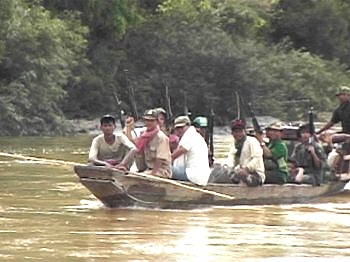 Once the perimeter was secured, three generals stepped out of their Land Cruisers and enthusiastically approached us, their personal bodyguards close behind. The generals looked friendly. Their bodyguards looked seriously unfriendly! The generals, whom we had not met until now, hurried right up to me and each of my men and gave us big hugs, hand shakes and slaps on the back, like we were long lost sons. The bodyguards stood there with machine guns pointed in our general direction, doing what they were supposed to do to ward off any potential menacing threat to their leaders–which, by the way, never crossed our minds. We did the natural thing; we acted like long lost sons!
Once the perimeter was secured, three generals stepped out of their Land Cruisers and enthusiastically approached us, their personal bodyguards close behind. The generals looked friendly. Their bodyguards looked seriously unfriendly! The generals, whom we had not met until now, hurried right up to me and each of my men and gave us big hugs, hand shakes and slaps on the back, like we were long lost sons. The bodyguards stood there with machine guns pointed in our general direction, doing what they were supposed to do to ward off any potential menacing threat to their leaders–which, by the way, never crossed our minds. We did the natural thing; we acted like long lost sons!
We had not been in Cambodia even for one hour before we were packed into Land Cruisers of our own and driven to Kampong Saom on the coast–which was almost half way across Cambodia. The end of the dry season had caused the water levels in the Mekong River to drop so low that deep-water ships were no longer delivering cargo to Cambodia’s capital, Phnom Penh. Therefore, it was necessary for us to go to Cambodia’s only other deep-water port in Kampong Saom to take delivery of five full ocean shipping containers of mining and additional equipment, supplies, boats and vehicles that had been shipped over there from America to support our project.
Since nothing happens immediately in Cambodia, we ended up spending about a week at a gorgeous beach while waiting for the shipping containers to be released by Cambodian Customs. Our hosts were taking good care of us. The hotel was comfortable, the beer was cold and the crab meat was freshly cooked on the beach–and it was all we could eat. In fact, we were just about getting bored. That’s when the generals showed up.
Isn’t it amazing how fast boredom can turn to fear? After hugs and handshakes, the generals agreed it was time for target practice. They had their bodyguards throwing beer cans out into the water so they could shoot at the cans. Pretty soon, lots of people were shooting at them. The few civilians that had been enjoying the beach scurried off quickly and respectfully. Everyone was laughing and having a good time except us. We were laughing, but not sure if we were going to be the next targets! It was all too much at once. We didn’t even know these people and they were all enthusiastically shooting their guns off. We were surrounded!
Pretty soon, one of the generals handed me some kind of machine gun I had never seen before and challenged me to shoot a fresh beer can. It was the only beer can remaining on the beach! This was a tough position for me to be in; those guys were not the best shots. I calculated whether I should try to out-shoot them, which might cause the generals a loss of face in front of their men, or to miss the can and perhaps lose their respect? On an impulse, I clicked the machine gun over to full automatic and fired a short burst to find a mark, adjusted slightly, and hit the can, knocking it up into the air on the second burst. No one had used automatic fire–probably to conserve bullets. All the generals burst out in a roar of laughter, followed by all their men. Deciding to quit while I was ahead, I handed the machine gun back to the general with the clip still half-full of bullets. That was the end of target practice and the beginning of my very warm friendship with that general. About a week later in Phnom Penh, this general and his very kind family, with great ceremony, adopted me as their number-one son.
The beach was just the beginning of 60 days of non-stop adventure which took me and three of my men from one end of Cambodia to the other in search of gold and valuable gems.
As it turned out, the generals were directly involved with this exploration project–which, by the way, was the first precious metal exploration project in Cambodia since the United Nations returned control of the country to a Cambodian coalition government in late 1991. During the course of the project, it became abundantly clear that our presence, and our successful venture, was very important to these generals and the Cambodian government. Cambodia is just getting back on its feet after decades of war and agony. The country is hungry for capital investment from the east and west. Successful ventures such as ours would help facilitate that.
Our project took place in northeastern Cambodia on one of the three main tributaries of the Mekong River. We were hired to help this operation put its suction dredging equipment into production and to help find high-grade mineral deposits.
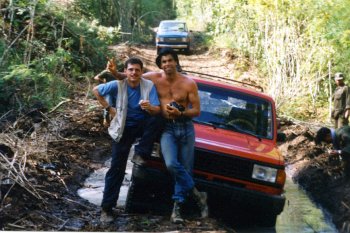 The area is remote. In fact, it is the same area America bombed in the early 1970’s (with B-52’s) to prevent the Viet Cong from moving supplies on that portion of the Ho Chi Minh Trail. You just would not believe the number of bomb craters; I have never seen anything like it. In fact, up until the time of our project, I don’t believe a single bulldozer had visited that section of Cambodia since we bombed it! While these conditions probably never did slow down the Viet Cong very much, they certainly did slow us Americans down a lot! It took literally weeks for us to transport our equipment to the work-site. Trucks and trailers would disappear into craters and then come back out, one after the other, like a big roller coaster ride–only in slow motion–for hundreds of miles! It was one of the most amazing things I have ever seen!
The area is remote. In fact, it is the same area America bombed in the early 1970’s (with B-52’s) to prevent the Viet Cong from moving supplies on that portion of the Ho Chi Minh Trail. You just would not believe the number of bomb craters; I have never seen anything like it. In fact, up until the time of our project, I don’t believe a single bulldozer had visited that section of Cambodia since we bombed it! While these conditions probably never did slow down the Viet Cong very much, they certainly did slow us Americans down a lot! It took literally weeks for us to transport our equipment to the work-site. Trucks and trailers would disappear into craters and then come back out, one after the other, like a big roller coaster ride–only in slow motion–for hundreds of miles! It was one of the most amazing things I have ever seen!
All the while, our security troops were worried about being ambushed by Khmer Rouge rebels–roving bands which were still occasionally shooting up taxis, burning bridges, robbing various business establishments and causing other acts of terror around the countryside. Our generals were very concerned to make sure there were no embarrassments on this operation. Therefore, they sent along a 300-man military force to provide security. Each of us was also assigned several personal body guards. They also issued each of my men and me our own machine guns–which we gladly took. You kind of feel naked without a weapon when everyone else is walking around with some kind of heavy fire power! Here follows some video segments that I captured of our interaction with our bodyguards and some of the troops that were assigned to our project:
By the way, the people of Cambodia are the kindest-natured people I have ever associated with. Everyone is very polite and friendly. Unless it is worth dying over, you never see an argument in Cambodia! During the entire 60 days of our project, there was not a single person I smiled at that I did not receive a heartfelt and sincere smile in return. They seem to genuinely like Americans. In fact, any product or item that says Made in America is in great demand in Cambodia–especially hats and insignia which carry American flags and symbols.
One night, we had to make an emergency dash through rebel-held territory so that we could meet a production deadline. We were driving like madmen through bomb craters, up and down, with grenade launchers and machine guns hanging out windows. Our security people were very concerned we would be ambushed. Better to be safe than sorry, I suppose. But, I never saw any direct sign of danger. Even so, the eminent concern–with guns and grenades pointed out windows, with everyone on moment-to-moment alert–created a charged atmosphere which we usually only experience on television in America.
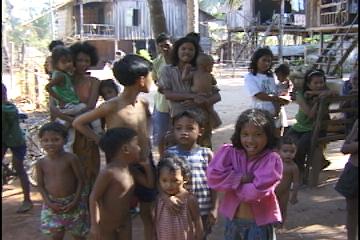
We received incredible hospitality from native villagers in every community that we passed through or stopped to visit. Many villagers had never seen white men before. You have to remember that Cambodia, for the most part, lost an entire generation of people to the Khmer Rouge regime. Locals told us the ratio of women to men in Cambodia is five to one, because the men were either killed in war or murdered. That ratio is about how it appeared to me.
The equipment we sent there to use for sampling took a very heavy beating during the trip across Cambodia. The axles we mounted on the dredge platforms were badly bent from being dragged through hundreds of craters, and there was quite a lot of other damage, too. So we found ourselves staged for about a week in the last town before we would reach the river. This was a place where various supplies and services were still available. There, my men and I supervised final repairs and preparations for our sampling program. It is very challenging to do this sort of thing in an environment where most of your helpers do not think the same as you do, and do not speak any of your language:
Between the delays at Customs, the painstaking trip across war-torn Cambodia with the equipment, and the time we had to spend repairing gear at the final staging area, we only had about 2 weeks remaining to accomplish what we went to Cambodia for in the first place. A final distance to the river of 35 kilometers does not sound like very far; but in Cambodia, where anything and everything can go wrong; this last 22 miles still seemed like a long way to go. Even so, there was a lot of excitement when we had everything ready and began our final journey to the river from the last bit of civilization that we would see. The following video segments demonstrate the excitement that we were all feeling to finally get started on our dredge sampling program:
Along the way to the river, we started seeing lots of diggings alongside the road. We thought the holes were water wells at first, because they were perfectly round and uniformly about 2 ½ feet in diameter. Then we realized they must have been something else, because there were so many, and they were positioned so closely together. We stopped to take a look as soon as we saw some locals actively working inside one of the holes. These turned out to be sapphire miners! They were digging about 10 meters down to bedrock and recovering handfuls of pretty blue stones from the bottom gravels. These miners were selling their gemstones for mere pennies (Me and my guys were buying!). We found out these miners were from the Cambodian hill tribes; jungle dwellers that pretty-much are the same as they have been for hundreds or thousands of years. A number of humanitarian groups are now present in Cambodia attempting to prevent the modern world from impacting too dramatically upon these ancient tribal people. The following video segment captured some dialog that we had with a few of the sapphire miners. It presents a good example of how simple and kind the people are from the Cambodian hill tribes:
Immediately upon our arrival at the river, we realized that we had 2 serious problems to overcome. The first was that there was about a 10-meter drop from the bank down to the active river. There was no ramp or other simple way to launch the 10-inch dredge and special recovery platform that we brought with us for this job. Not wanting to use our security force for this, we immediately set out to hire around 30 men from the local hill tribe village to dig a ramp. That exercise took about 6 days to accomplish. So we were not going to have use of the big dredge until the final week of our project.
Our second serious problem was that the (sizable) river water was running mud-brown. We did not know it at the time, but there was some active dam construction happening upstream in Vietnam. The ongoing construction was turning the river to mud-water. That meant that we were not going to have any visibility underwater. There is a way to get the work done in dirty water; but besides the serious safety problems associated with dredging blind on the bottom of deep tropical rivers, you have to do everything by feel. This slows you down to just a fraction of what you can accomplish with some underwater visibility. This was going to be a difficult mission to accomplish!
All travel on the river from our base camp had to be accomplished by boat. The boat that we arranged broke down on our first trip downriver to survey the area. As it was just before dark on our return to camp, and the mechanical problem seemed pretty serious, we actually started making plans to sleep on a sand bar that was located out in the middle of the river, maybe 5 miles away from our camp. With no dinner and no shelter from the mosquitoes, it was a pretty bleak feeling out there. I captured the following video segment just as our guide was suggesting that we spend the night there on the sand bar. Fortunately, they got the boat motor operating just as darkness was almost complete. It sure felt good to finally arrive back at camp that night where there was a hot meal and perfectly good tent waiting for each of us:
While we were doing our initial survey downriver, we came upon a local river mining operation that was using a long-handled (about 15 feet long) shovel, suspended by a floating platform made of bamboo. This dredge was being used to excavate sand off the bottom of the river. The locals called this a “Vietnam dredge,” because the river mining technology had been imported by miners across the border in Vietnam. Almost the entire dredge was made out of materials from the jungle. Even the lines being used to tie off the dredge out in the river were made from jungle vines. The only part of the dredge we could see that was from our modern world was the head of the shovel. That looked to be fashioned from the car hood of a bombed-out jeep. This river location was part of the Ho Chi Minh trail. So there were plenty of bombed-out jeeps around, and some ruined Vietnamese tanks, too. In fact, there was a lot of painful history here!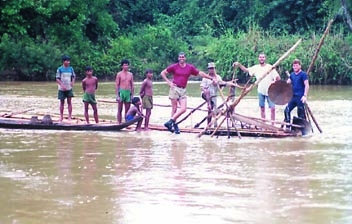
Author and several team-members trying out a “Vietnam Dredge,” made from bamboo, which local miners use to bring gold off the bottom of the river.
Upon discovery of the local river mining program, we immediately took the opportunity to make friends with the local miners and the elders of their village. This is standard procedure anytime we are performing an preliminary evaluation in a new area. While their methods might sometimes be somewhat primitive compared to ours, I have found more often than not that hundreds (or thousands) of years of local mining experience has given the miners who occupy an area a strong perception of where the richest gold areas are located. We did not have much time remaining to make a rich discovery for our clients. Any head start the locals could give us would surely be a welcome development! Ultimately, the locals told us that their dredge was positioned along the strongest line of gold that they knew of in the river. That was a big help!
To get an idea of how much gold they were talking about, we accepted their invitation to go down and operate their Vietnamese dredge for a little while. The following video segment captured my guys running the local production equipment. It worked by pushing the shovel down into the sand, and then using a make-shift windless to raise the river-bottom material to the surface. There, local wooden gold pans were used to process the material:
While the local miners were recovering a fair amount of gold from the river-bottom sand deposits, their success did not appear to help us very much. This was because we wanted to sample for the high-grade gold deposits which are almost always located at the bottom of hard-packed streambed layers. In working their Vietnamese dredge for awhile, it did not take very long for us to realize that the long-handled shovel would not penetrate the hard-packed streambed material that was under the sand. Too bad!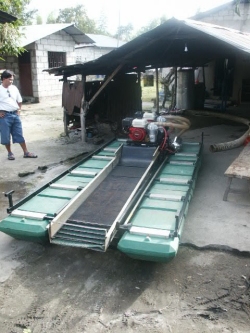
5″ Pro-Mack Sampling Dredge
Still, knowing where local miners were supporting their villages with gold from the river gave us a starting point. The following day, we moved two 5-inch special sampling dredges onto the river some distance downstream from where the locals were mining, but directly in line with them so that we had a better chance of sampling on the strongest path of gold in the river
My guys were initially quite challenged by going down into the pitch blackness along the bottom of a muddy, tropical river. Because there is zero visibility down there, everything must be done by feel. This is not easy to do, because your imagination cranks up into overdrive about what might be lingering around down there to bite or eat you in the dark. Remember those horrific nightmares you had when you were a kid? That stuff doesn’t ever go away. The terror is still present; it is just buried. Going by yourself down to the bottom of a tropical river in total darkness, and having to feel your way around to figure out what is down there, energizes all you nightmarish fears right back to the surface. It is difficult to do what you are supposed to do down there with all this internal fear playing out inside of you! It takes courage and a lot of discipline.
So my guys challenged themselves with acquiring some preliminary sample results using the 5-inch dredges, while I was pulling the 10-inch dredge together and installing a special shaker table in the base camp that we would be needing to process large samples. The table needed to be anchored in concrete. All of this took several days. Time was running out!
On the second day of sampling, our lead diver, Alley Norton, touched down in some hard-pack and came up with a pretty good showing of gold. The following day, I encouraged Ally to go back down and open up the hole (get a bigger sample). We had to keep dredgers separated while sampling, to avoid someone getting smacked with a cobble being tossed in the dark. There simply is no way to tell where anyone else is when you are dredging in muddy water. Alley’s hard work and enthusiasm paid off. Considering how small his sample actually was because of the dirty water, he recovered a lot of gold! We had located high-grade!
I captured these following video segments towards the end of the third day of sampling:
As we had less than a week remaining to accomplish our mission, we all focused the next several days placing the 10-inch dredge and platform into the water. The local help had completed our launch ramp according to plan. Wow, was that a lot of work! Once the big dredge and recovery system were floating in the river, we still had to dial it all in to get it working right. This was particularly important with the sophisticated recovery system that we had brought along for this job.
Before opening up Alley’s discovery with a production sample, we needed to make sure the recovery system was working right. This all took another two days, because the large volume of sand from the bottom of the river was overwhelming the gravel pump that was supposed to transfer classified material to the recovery system. This problem required us to get very creative in the middle of the jungle. Through some trial and error, we constructed several water blasters to inject water into the feed of the gravel pump. This made sure that enough water was going into the feed to keep sand from packing up in there. While all of this took up valuable time, we had to get the big dredging system fully functioning before using it to perform the final production samples in Alley’s rich discovery
We only had 2 days remaining on the project when we finally floated the big dredge over Alley’s rich discovery. Talking about racing against the clock! So while Alley went down in 6 meters of underwater darkness to suck up the sample, I stayed up on deck to fine tune the dredge’s recovery system. You can only put one diver down on a big, powerful dredge in dark water. So our other guys helped where it was needed. Alley spent several hours opening up a large hole through about 2 meters of loose sand. Our plan was to first pump most of the sand off the hard-packed streambed material where Alley had found the gold. Then we were planning to flush the sand completely out of the recovery system before dredging up the pay-dirt. This was to minimize gold losses because of too much sand overwhelming the system at once.
We were making good progress on our plan. But about half way through the day, Alley climbed back onto the dredge with a lot of blood flowing down the right side of his head and face. A pretty sizable chunk of his right ear was missing and it was bleeding profusely! Blood was actually squirting out with the pulse of his heart! He said while operating the dredge’s suction nozzle on the bottom of the river, it felt like a submerged log with rough bark brushed by his head, scraping his ear. When he reached up to touch where the pain was coming from, he could feel that a part of his ear was gone. That’s when he came to the surface. Seeing all that blood and the bite out of Alley’s ear was very dramatic for everyone that was present.
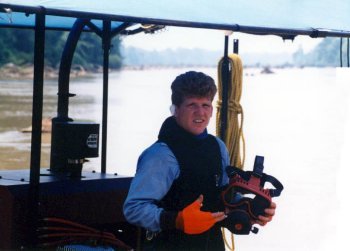 Back at camp, we bandaged Alley up as best we could. We always bring a substantial medical kit with us on these projects. We applied antibiotics just to be safe. Alley said the pain was not too bad. He was mostly worried about how ugly it was all going to look later. I would have been worried about that, too! There wasn’t anything else we were going to do about that situation out in the jungle, though. So we decided to set aside that problem for another time. We were going to depart Cambodia in a few days, anyway.
Back at camp, we bandaged Alley up as best we could. We always bring a substantial medical kit with us on these projects. We applied antibiotics just to be safe. Alley said the pain was not too bad. He was mostly worried about how ugly it was all going to look later. I would have been worried about that, too! There wasn’t anything else we were going to do about that situation out in the jungle, though. So we decided to set aside that problem for another time. We were going to depart Cambodia in a few days, anyway.
Collectively, my guys and I decided it was wise to not do any more diving in the river until we found out what bit Alley. Whatever it was, there was a chance that we could still salvage the sampling project by wearing more protective gear while underwater. We still had one more day available to perform a final production sample!
As none of our bodyguards or the other military guys in camp seemed to have any idea what bit Alley, we decided to drive the motor boat up to the hill tribe village where the Vietnamese dredge was operating. We had already made friends with the villagers and elders there. Once there, we removed the bandage from Alley’s ear to show the elders, and they immediately knew what bit him. They told us that there is a fresh water blow fish that lives on clams at the bottom of the river. Apparently, this type of fish must have come alongside Alan’s head; and in the very poor visibility, thought his ear was a clam. One bite and there it went. The villagers assured us we would have no further problem with that fish if we started wearing hoods, gloves and full face helmets in the river while it was muddy.
Afterwards, we heard the story of one of our military men bathing naked in the river and losing his vital organ. Apparently, the man had just been married several weeks before. Luckily, we had been taking our showers up on the bank!
When we arrived at their village, the local people were busy preparing for a “grand celebration” that was to take place that evening. All of us were invited to attend, and it would have been impolite for us to decline their kind hospitality. The celebration turned out to be a funeral ceremony for one of their important elders who had died 3 years before. I have seen similar traditions in Madagascar, where the big celebration of someone’s life happens by the whole village several years after the person dies. These hill tribe people were busy decorating a whole shrine that would be dedicated to the person, carving all sorts of symbols relating to the important things the person lived through. Interestingly, the biggest symbols I recognized were American military helicopters and B-52 bombers. No doubt, the later part of the Vietnam war must have been a very traumatic time for these very simple hill tribe villages, with the Viet Cong using their river for a highway, and the Americans dropping thousands of tons of bombs all around.
These people seemed nothing but pleased to have us Americans present, so we accepted their invitation to participate in their party that evening. Indeed, the party turned out to be one of the most interesting events I have ever been part of. A center covered circle had been built for the people who wanted to express their grief over the loss of a loved one. Inside that area, there were around 20 people who were crying and almost howling in deep grief. Outside the circle, the rest of the village paraded round and round in a dance in joyous celebration of the person’s life.
My guys and I jumped in with the outer group. They were beating on different-sounding chimes to make their traditional music. The sound was so interesting that I captured it on tape. The occasion was something I am sure that none of us will ever forget. We were honored that they allowed us to participate in such an important tribal event. They were honored that we joined in with them. It was a wonderful bonding experience between us and remote villagers of the deep jungles of Cambodia. The following video segment and audio segment capture some of our hill tribe friends as they were preparing for the party, and then capture some of the music and feelings that we shared together that evening:
Hill Tribe Music:
The following morning found our team back on the 10-inch dredge, preparing to perform one last production sample. This was our last day to accomplish what we went there to do. So much effort and money had been invested to transport this fantastic equipment halfway across the world, through some of the most difficult circumstances on the planet; only to finally arrive on our last day right over top of what appeared to be a very rich gold deposit.
It was so important that we get the best possible production sample, Alley insisted that he take the first dive. He had started the sample on the previous morning, so he knew the layout of the hole in the total darkness of the river bottom. Total darkness down there would have required either of my other two guys to spend valuable time figuring out what Ally had already done. As this gold deposit was really Ally’s personal discovery, we agreed that he would take the first dive of the day to open up his hole. I would spend that time dialing in the recovery system as well as I could. Then I would finish the sample during the afternoon with a second long dive. My other two guys were content to support us from the surface. I don’t think they were quite over the emotional shock of Alley’s blood and guts from the day before. Who could blame them?
As I knew this would be a memorable occasion that none of us would ever forget, I captured some video of Alley bravely overcoming his fears and going back down into the deep black hole that attacked him on the previous day, something very few people would do. You will see from the following video segments how good the production dredging equipment was that we managed to place on top of that rich gold deposit. I believe the recovery system was the most sophisticated that had ever been used with a suction dredge up until that time. It was truly a miracle that we ever got the equipment there, or that we found such a high-grade gold deposit under those difficult conditions. With all that we had been through, in my world, there was no other choice but to perform that final production sample:
After a few hours of diving, Alley came to the surface; because his ear was throbbing in so much pain, that he said he could no longer focus on what needed to be done on the bottom of the river. By then, the recovery system was dialed in as well as we were going to get it. So I suited-up and went down into Alley’s deep, black hole. This was actually my first dive on this entire project. During the week or so that we had been on the river, there were just too many other things that needed to be accomplished which only I could do to bring everything together in time for this final production sample. So there I was, taking the last and most important dive of the whole project!
I will never forget in military jump school, the first time I bailed out of an airplane. It was one of those situations where I really did not have much of a choice. But looking way down there at the ground made jumping feel totally wrong. My body did not want to do it. So it was necessary for me to flick some internal emotional switch, override my natural instincts, and just force the body to make the jump. Going down into deep muddy water is much the same; the body does not want to do it!
I have actually done quite a few dredging projects where it has been necessary to perform the underwater work in muddy water. It is never easy! Especially when the water is deep! It was around 6 meters just to the bottom of this dirty river. That is a long way to go down in the dark. I worked my way down there slowly by following the suction hose, which is where I knew that Alley had left off. When I reached the suction nozzle, I rotated my body around it in a circle, feeling around with my legs and feet to try and find Alley’s dredge hole. Letting go of the nozzle was something I was not prepared to do, because it was the only thing that gave me a reference point down there in the total darkness. Also, feeling around tentatively with steel-tipped work boots felt safer than reaching out in the dark with my hands!
I soon found that Alley’s hole was just off to one side of the nozzle. Experienced dredger that he is, Alley knew better than to leave an unattended suction nozzle down inside of a dredge hole in the sand. The walls never stop sliding in on sand-excavations or loose gravel. If you leave a suction nozzle down inside of one, within just a short time, the suction nozzle and hose will be overwhelmed and buried. That would have been the end of this project. There was not enough time remaining to dig a hose out of the sand in the dark!
Once I found Alley’s hole, I memorized where the suction nozzle was positioned several feet away, and then I followed the edge of the hole all the way around to get some idea how big it was. This was the hard part, because it meant that I had to reach out and feel everything with my hands. All that blood pouring down the side of Alley’s face the day before was vividly on my mind! There were creatures down there with serious teeth! Here is where I had to flick another fear-switch off and just do the work. These fear switches are not really turned off. They are just suspended. I speak from bad experience. Depending upon how many of your internal fear-switches are in suspension, it just takes one small event to turn them all back on into nightmarish panic and terror. I have been there. It is not fun!
Reaching out meant feeling out as far as I could outside the outer edge of Alley’s hole to make sure there were no boulders up there that would roll in on me in the dark. I did not find any. Slowly but surely, I explored all of Alley’s hole by feel. It was pretty big; maybe 30 feet in diameter at the surface, funneling down to a center point about 2 meters deep. Alley had pumped a lot of sand! Before I went down, he told me that he touched down on the hard-pack streambed at the bottom of his hole, but that the sand kept sliding in on him. So he had not been able to get a sample of the hard-pack, yet. This was for me to do!
I invested about 2 hours into taking a sizable cut off the front and one side of Alley’s hole, working the sand back step-by-step in the darkness. I wanted to uncover enough surface area of the hard-pack as possible. This was so that further sand-slides would not prevent me from getting a good sample of the hard-pack. With time, I started uncovering the hard-pack. This is where the loose sand met the cobbles, boulders and gravel that were tightly compacted together. Though I could not see it, it felt just like the hard-pack we dredge along our properties in California.
While the dredge was plenty powerful enough to pull apart the compacted streambed material, my progress was slow. This is because I could not see the oversized rocks that had to be moved out of the way, and I could not put my hands out in front of the nozzle in the dark without getting them hurtfully banged up. Mainly, I just poked around down there in the dark to suck up anything that would go up the nozzle. Each time a loose cobble would block the nozzle opening, I would wrestle it off and put it behind me. It was not long before I had more loose cobbles behind me than I could manage. It was too far to throw them out of the hole, and trying to pack them out would have caused more sand to slide in. So I just juggled everything around down there the best I could, determined to get as much of that hard-pack up the nozzle as possible. Ultimately, my progress became overwhelmed by loose cobbles in the hole and sand sliding in from the sides. I had not reached bedrock, but I did get a fair sample of the material that Alley had touched down upon with the 5-inch dredge several days before. By my measurements in the dark, I estimate that I sampled less than a cubic meter of hard-packed material. That was all we were going to get under those difficult circumstances. It was a good feeling to finish what we had traveled so far to do.
The guys turned the dredge down when I reached the surface. I had to wait at the ladder for the longest time to allow my eyes to adjust to the bright sunny day. As I was waiting, my guys were making a lot of enthusiastic noise about visible gold in the recovery system. When I finally was able to see again, I climbed up onto the dredge to see that the entire recovery system was inundated with a thick layer of small golden flakes. It was, by far, the most gold I have ever seen recovered out of such a small volume of gravel. This place was rich!
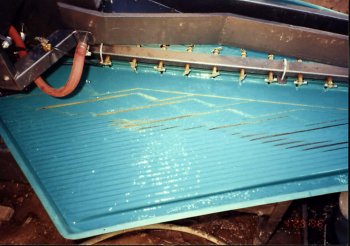 We had just enough time before dark to run our concentrates over the shaker table back at camp. Everyone there experienced an incredible feeling of pride. Under very difficult circumstances, against all odds, we stuck it out right until the last hour to make this project a success. Watching all that rich gold flow across the shaker table had all of us in awe about how rich this river is. Who would have ever guessed? Right there on the Ho Chi Minh trail! While I am sorry to have missed capturing the gold-laden recovery system on the dredge, I was able to recover myself enough to capture the following video segment of the final clean-up. To put it in perspective, our small sample caused that shaker table to flow gold like that for a full 15 minutes!
We had just enough time before dark to run our concentrates over the shaker table back at camp. Everyone there experienced an incredible feeling of pride. Under very difficult circumstances, against all odds, we stuck it out right until the last hour to make this project a success. Watching all that rich gold flow across the shaker table had all of us in awe about how rich this river is. Who would have ever guessed? Right there on the Ho Chi Minh trail! While I am sorry to have missed capturing the gold-laden recovery system on the dredge, I was able to recover myself enough to capture the following video segment of the final clean-up. To put it in perspective, our small sample caused that shaker table to flow gold like that for a full 15 minutes!
We returned to civilization the following morning, and departed Cambodia a few days later.
Follow ups:
 A short time later, our clients met with some serious misfortune by aligning themselves with the losing side in a power struggle over who would control the government in Cambodia. While they survived the events, they have been banned from the country forever.
A short time later, our clients met with some serious misfortune by aligning themselves with the losing side in a power struggle over who would control the government in Cambodia. While they survived the events, they have been banned from the country forever.
 Shortly after my clients found themselves in big trouble, all of the equipment and supplies we sent over (that they paid for in advance) were taken away. The only thing remaining there today that shows we were ever even present is part of a steel frame from one of the large floatation platforms. Everything else is long gone.
Shortly after my clients found themselves in big trouble, all of the equipment and supplies we sent over (that they paid for in advance) were taken away. The only thing remaining there today that shows we were ever even present is part of a steel frame from one of the large floatation platforms. Everything else is long gone.
 The wars in Cambodia are now long over. The people there are very friendly. You do not see guns there anymore. People are focused on getting ahead in business. They want to be like America. The government is trying hard to attract foreign investment.
The wars in Cambodia are now long over. The people there are very friendly. You do not see guns there anymore. People are focused on getting ahead in business. They want to be like America. The government is trying hard to attract foreign investment.
 Nothing since our project has been done to develop the deposit that we located. Although the government of Cambodia has offered to make an exploration license available, I have yet to raise the high-risk capital necessary to go back over and do something about what we found
Nothing since our project has been done to develop the deposit that we located. Although the government of Cambodia has offered to make an exploration license available, I have yet to raise the high-risk capital necessary to go back over and do something about what we found
 I made a special trip back to the site of our discovery 2 years ago. The bad roads have been replaced with a highway! Schools have been built in the village communities. The people out there were happy to see me. Most importantly, dam construction in Viet Nam was finished and the river was running clear!
I made a special trip back to the site of our discovery 2 years ago. The bad roads have been replaced with a highway! Schools have been built in the village communities. The people out there were happy to see me. Most importantly, dam construction in Viet Nam was finished and the river was running clear!
 While I was out there, I hired a local boat to take me downriver to see if anyone was doing anything with our deposit. Nobody was there. Even the Viet Nam dredges were gone! It appears that my guys and I were the only ones whoever really understood the significance of what we found there. Local miners cannot access the rich material using their technology. With clear water, we could process hundreds of times more hard-pack in a day than what I sampled down there in the dark.
While I was out there, I hired a local boat to take me downriver to see if anyone was doing anything with our deposit. Nobody was there. Even the Viet Nam dredges were gone! It appears that my guys and I were the only ones whoever really understood the significance of what we found there. Local miners cannot access the rich material using their technology. With clear water, we could process hundreds of times more hard-pack in a day than what I sampled down there in the dark.
The following video segment was taken in the very place where the earlier segment showed us operating the dredge:
 Alley and his brother are now managing a successful concrete business in Phoenix, Arizona. He never did anything to fix the bite out of his ear. Now he says the tattered look gives him personality and character. Since nobody will believe he had his ear nearly bitten off by a clam-eating fish while prospecting for gold at the bottom of a muddy river in the jungles of Cambodia in the middle of a war along the ancient Ho Chi Minh trail, he now just tells people that his ear was bitten off by someone while fighting in a bar on the north side of Phoenix. That’s already more adventure than most people can handle!
Alley and his brother are now managing a successful concrete business in Phoenix, Arizona. He never did anything to fix the bite out of his ear. Now he says the tattered look gives him personality and character. Since nobody will believe he had his ear nearly bitten off by a clam-eating fish while prospecting for gold at the bottom of a muddy river in the jungles of Cambodia in the middle of a war along the ancient Ho Chi Minh trail, he now just tells people that his ear was bitten off by someone while fighting in a bar on the north side of Phoenix. That’s already more adventure than most people can handle!
Note: This story was pulled together from the non-proprietary portion of an initial report from a preliminary evaluation of a potential production dredging project in Northeastern Cambodia. The opportunity to do something with this prospect still exists.
- Here is where you can buy a sample of natural gold.
- Here is where you can buy Gold Prospecting Equipment & Supplies.
- Books & Videos by this Author
- More Gold Mining Adventures
- Logistical Planning
- More About Suction dredging
- Schedule of Events






